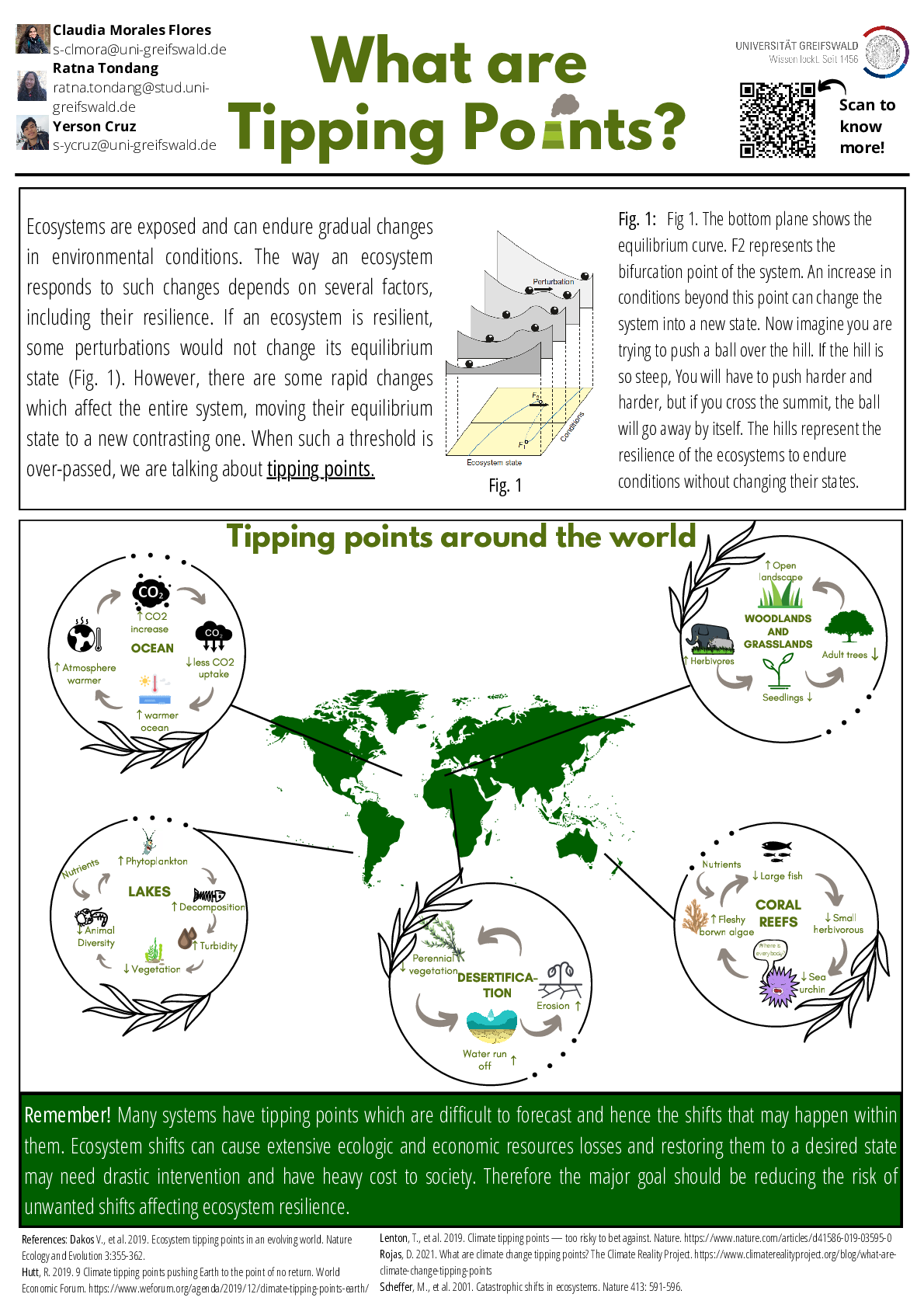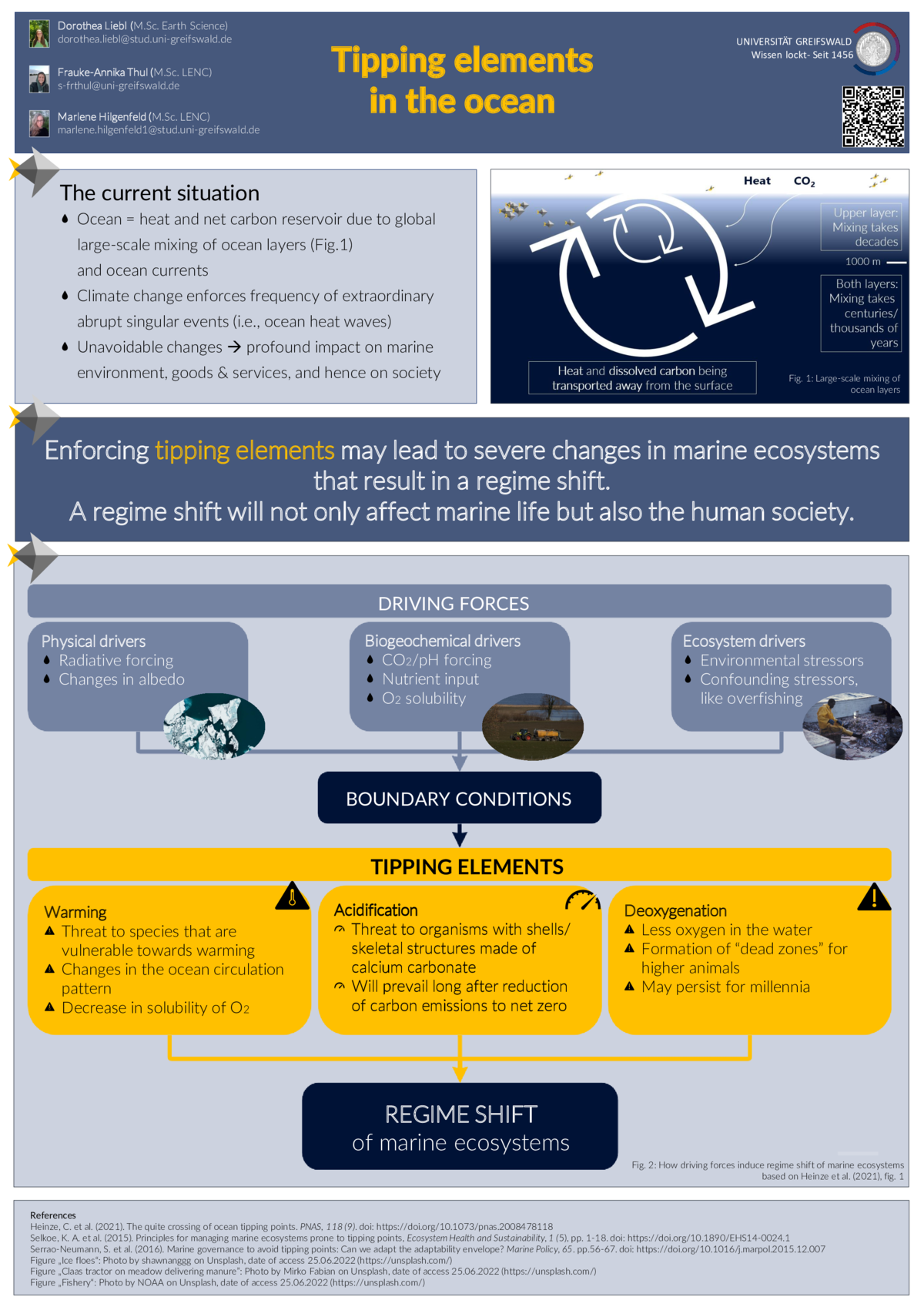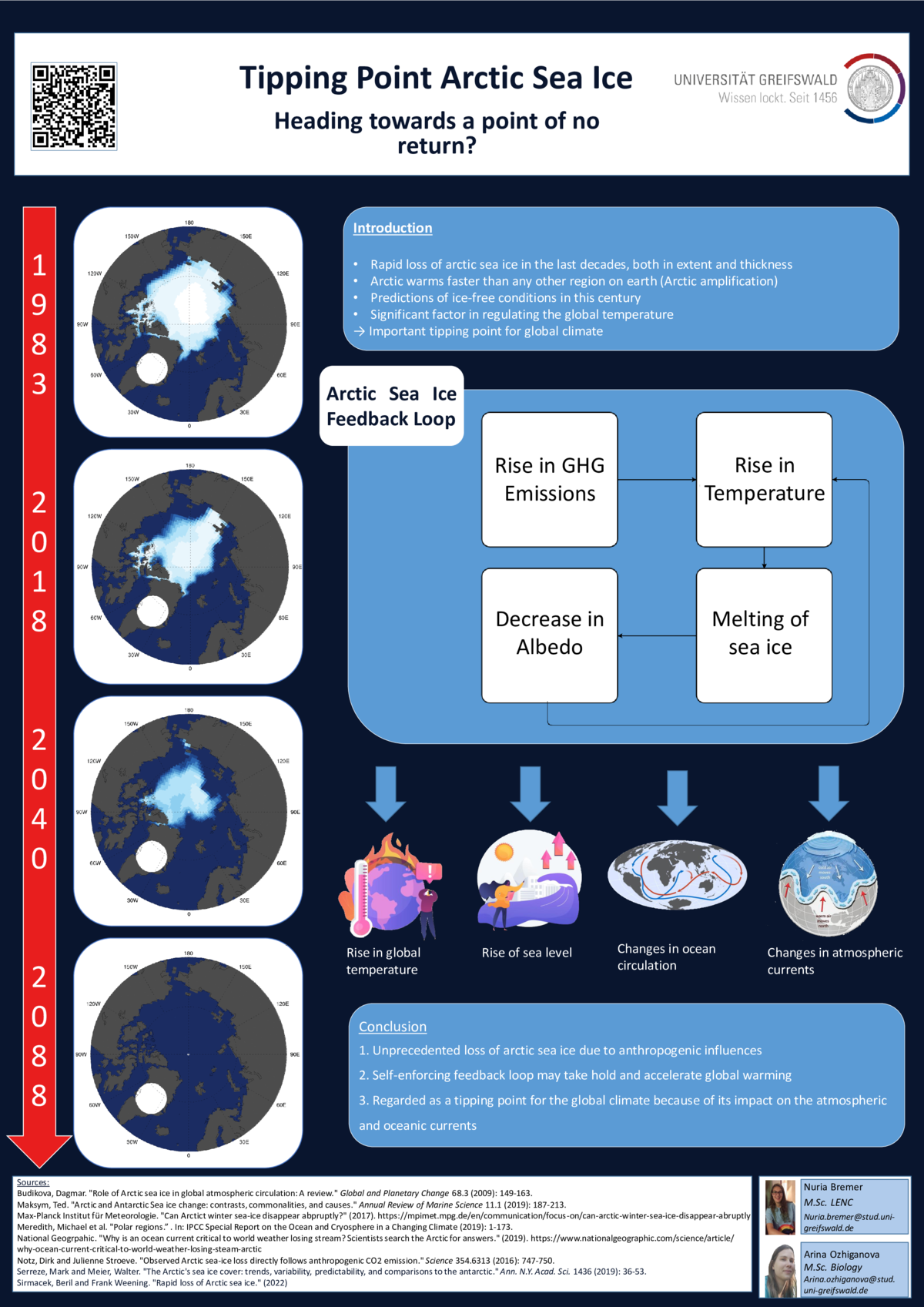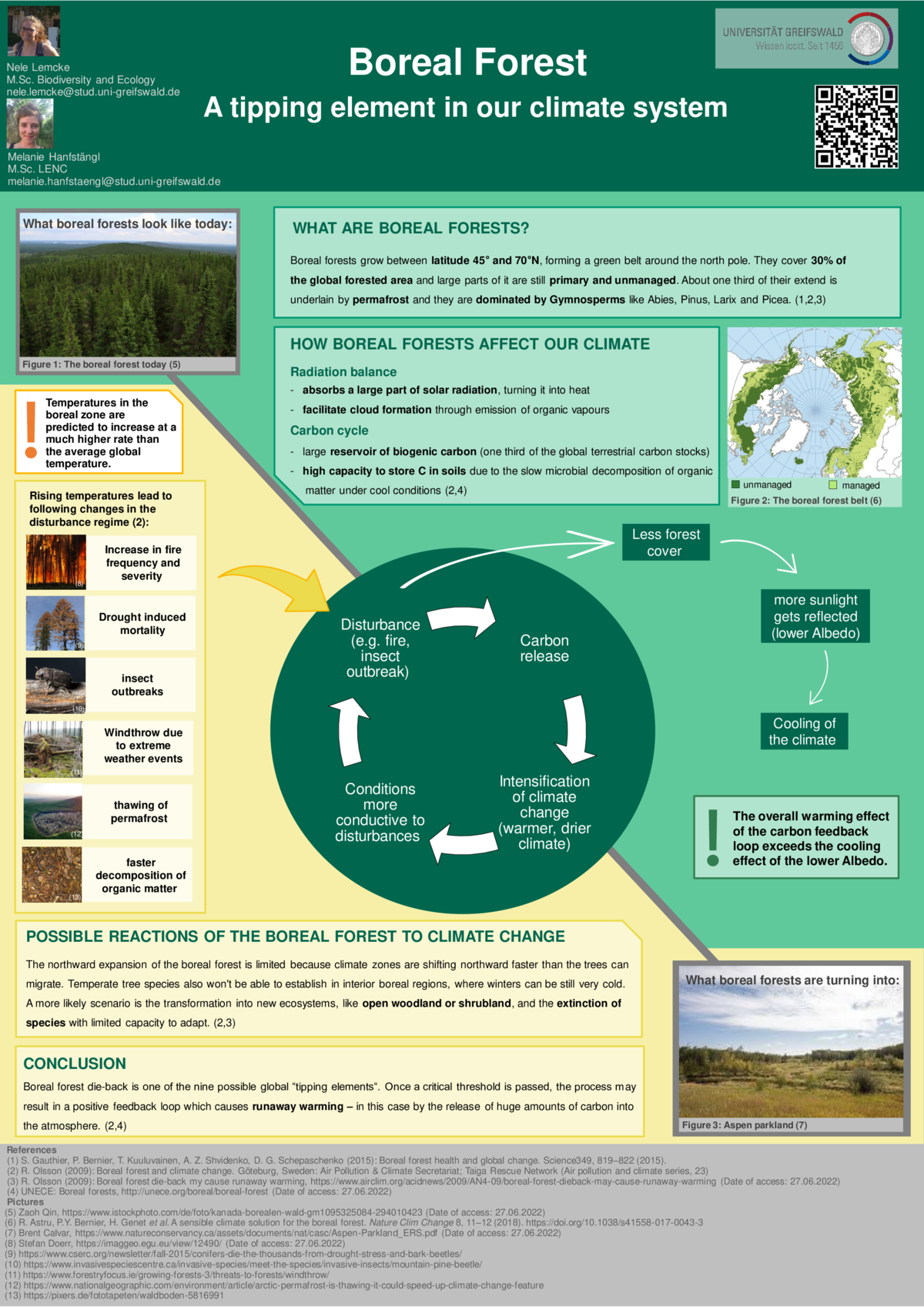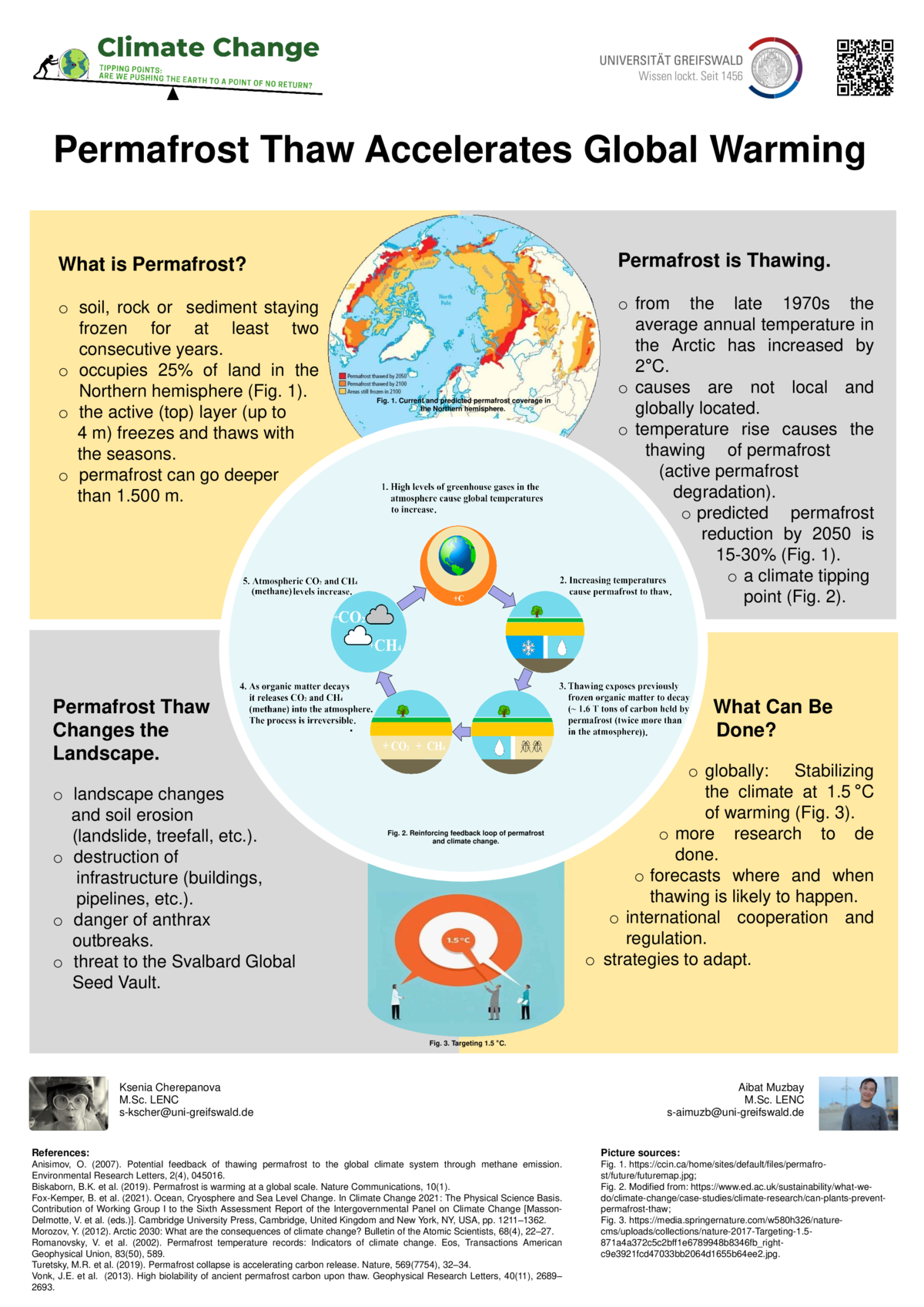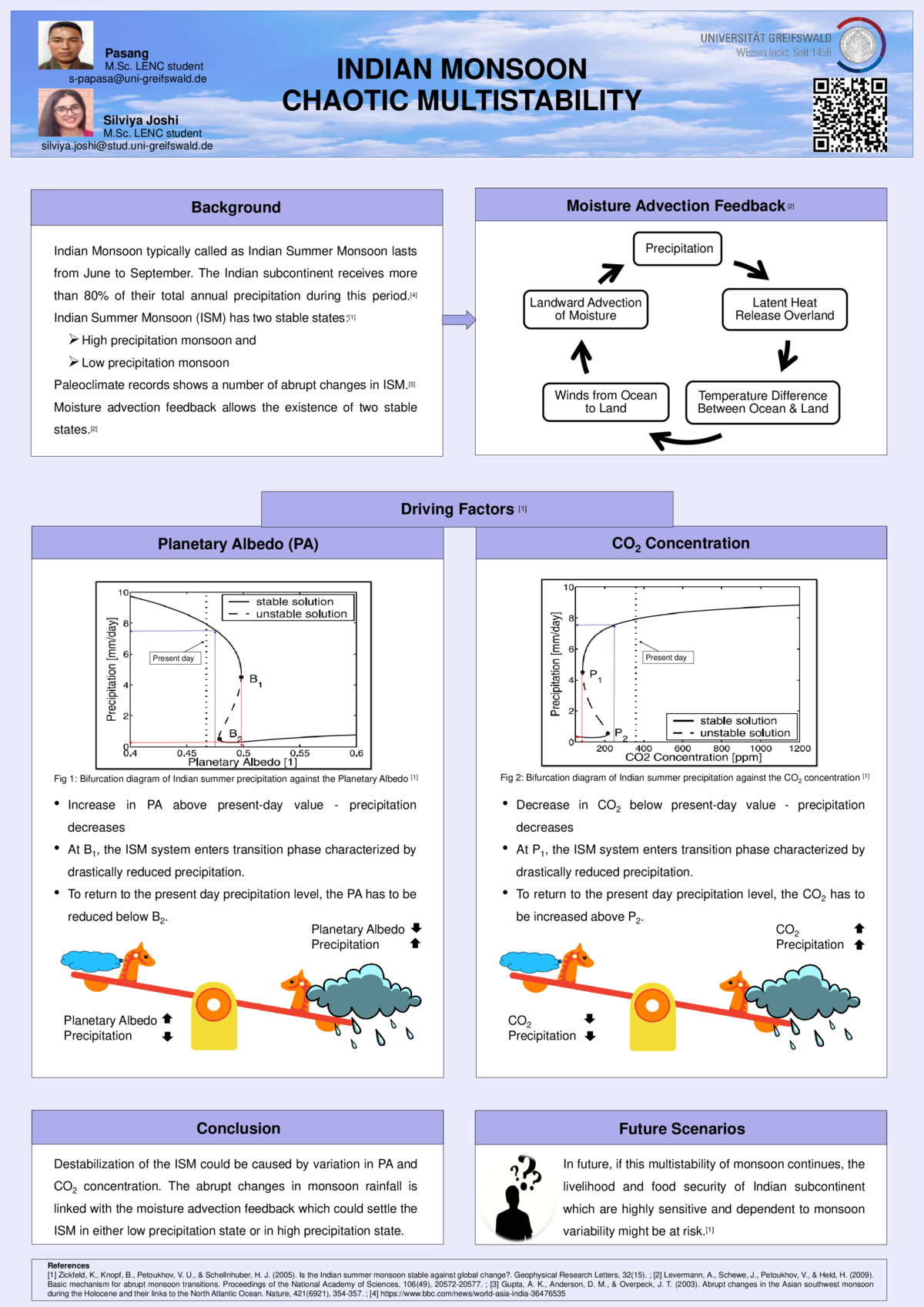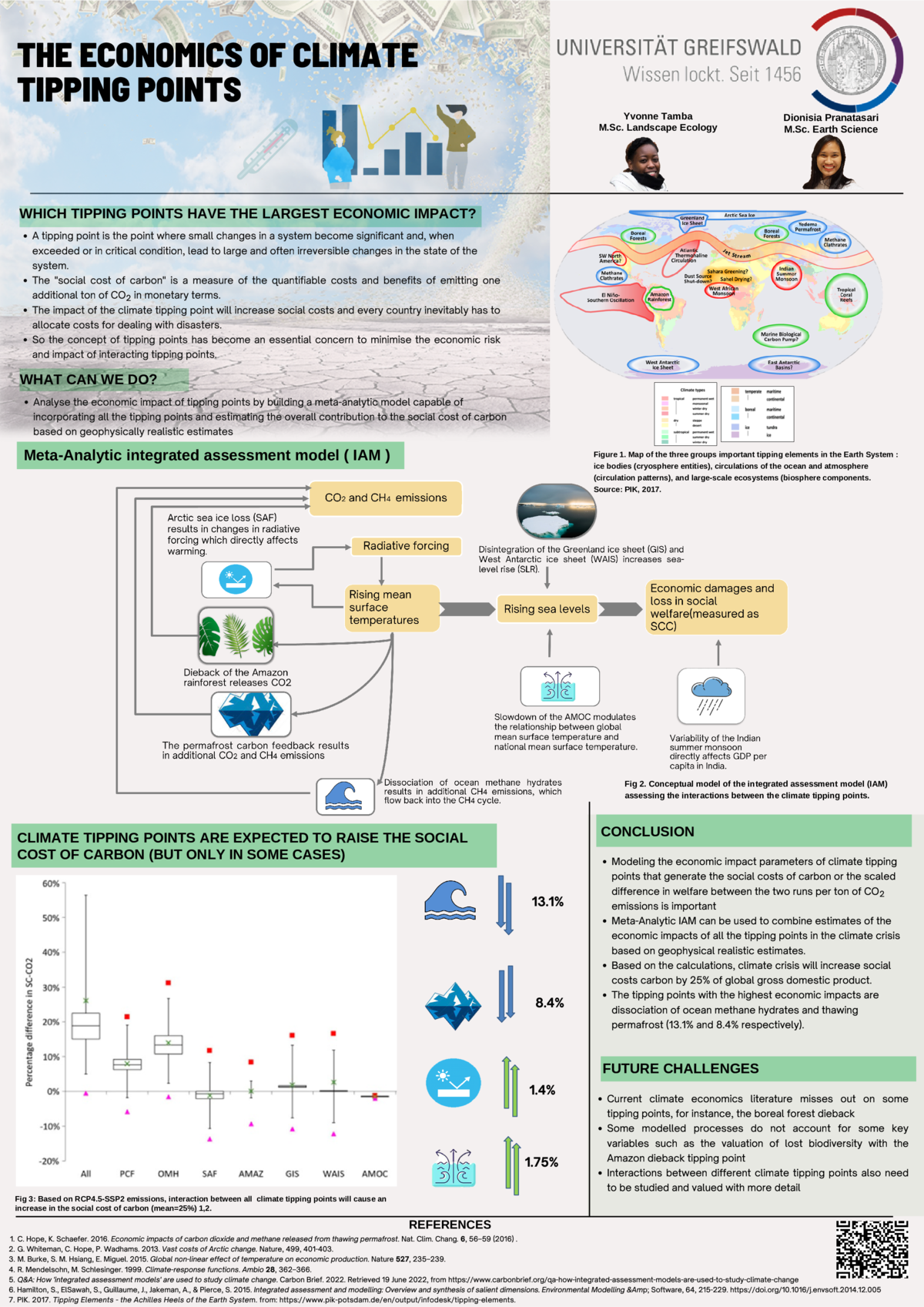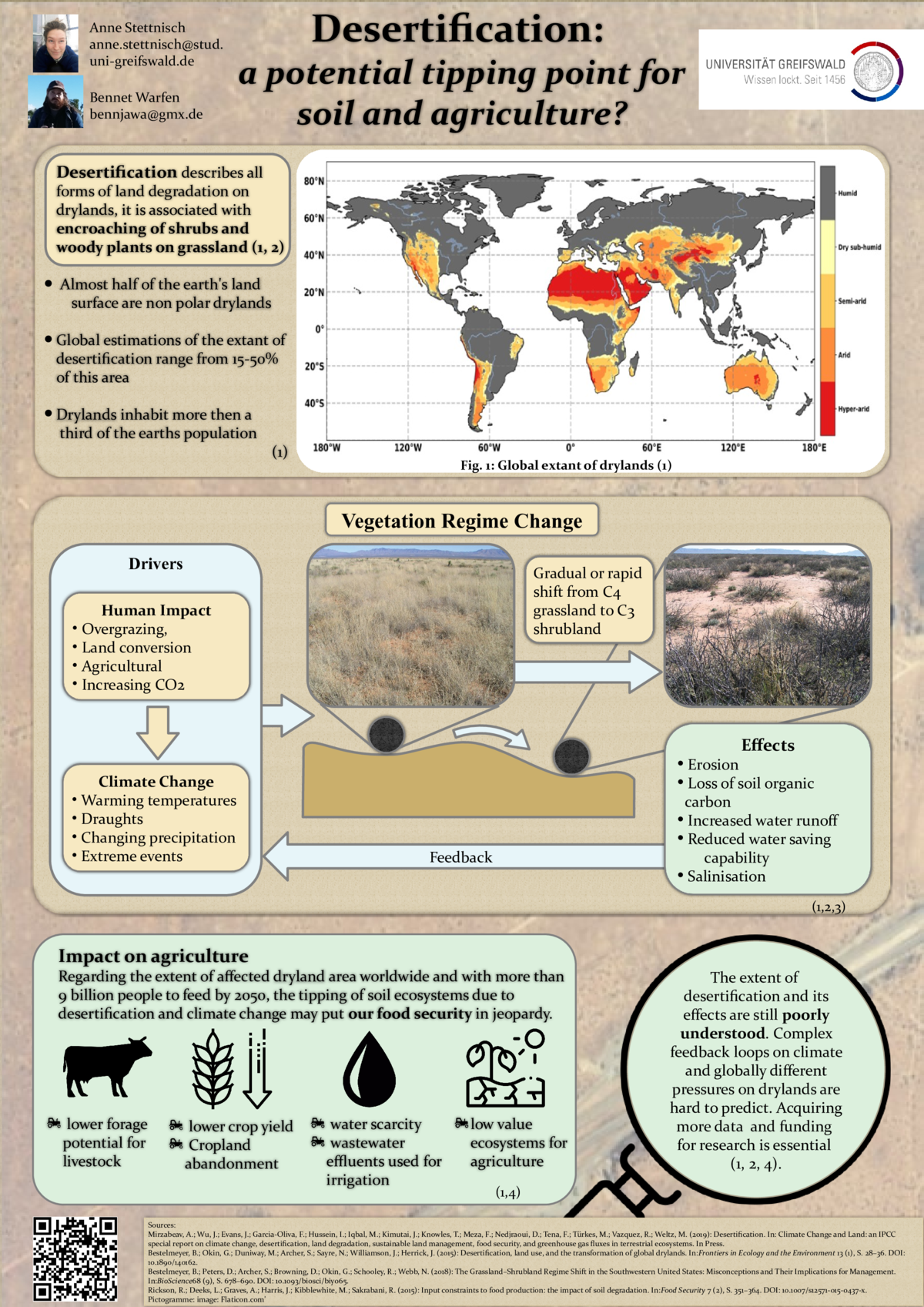
Below you can find all the contributions from students in the summer semester 2022 in the "Climate Change" module from Prof. Martin Wilmking, Ph.D.
For every topic you can find a short overview, the student's poster contribution and a 3 minutes video abstract.
Enjoy the virtual tour.
SESSION 1
General session: Tipping points
What are tipping points?
Imagine you are carefully climbing on a seesaw. First with completely stability, but then when you reach the middle the seesaw naturally tips in the other direction. This movement causes your fall and unable to stop its descent. Basically this is a tipping point. Ecosystems are exposed and can endure gradual changes in environmental conditions. The way an ecosystem responds to such changes depends on several factors, including their resilience. If an ecosystem is resilient, some perturbations would not change its equilibrium state. However, there are some rapid changes which affect the entire system, moving their equilibrium state to a new contrasting one. In other words, when a system over-passes certain thresholds, we are talking about tipping points. Check out our material and learn about what a tipping point is and some examples in the ecosystems from the world.
Tipping Elements of the Earth's Climate System
The term “Tipping Element” refers to large-scale components of the Earth’s system which may pass a tipping point in the future. Already small perturbations might be enough to have lasting effects on the whole climate system. A major forcing for these potential shifts in state is global warming and an exceedance of 1-2°C above pre-industrial levels could already trigger cascading effects. Come and see our poster to learn, where Tipping Elements of the Earth’s Climate system are located and how they are connected with each other. Check out our additional material, for even more information and details.
Tipping Elements in the Ocean
Our beloved ocean is not only good for snorkeling and boat cruises, it also provides one of the most important ecosystem service on earth. Since the industrial revolution, large amounts of the CO2 and heat added to the atmosphere by human activities have been taken up by the ocean and transported to deeper water levels. The changes that stem from this process already have a huge impact on marine and terrestrial life. This poster deals with the driving forces behind these changes and what oceanic ecosystems are pushed towards when they reach unavoidable tipping points.
SESSION 2
Tipping Elements of the Climate System
Tipping Point Arctic Sea Ice - Heading towards a point of no return?
The past decades have seen a rapid loss of arctic sea ice - both in its extent and its thickness. Even though the many interacting factors influencing the growth and loss of the ice make accurate predictions difficult, current research projects ice-free conditions in this century. The arctic plays a central role in the regulation of global temperature through atmospheric and oceanic currents, and once its tipping point is reached, a re-enforcing feedback loop with global consequences will take hold. This poster aims to highlight the underlying mechanisms of sea ice loss, as well as show its global consequences. what are global consequences of this.
Boreal Forest - A tipping element in our climate system
Boreal forests are one of the largest carbon reservoirs on earth. They store over one third of the global terrestrial carbon stock. Temperatures in the boreal zone are predicted to increase at a much higher rate than the average global temperature. On the one hand, boreal forests are therefore strongly affected by climate change, but on the other hand they also have a significant influence on our current climate. The following poster takes a closer look at which processes are responsible for this interaction and how boreal forests may look like in future.
Permafrost thaw accelerates global warming
Climate change is a process which greatly impacts and will continue to impact permafrost areas. Permafrost thawing caused by climate change leads to majority of impacts including greenhouse gasses release . These greenhouse gases previously stored in permafrost will accelerate global warming. Dangerous loop of temperature rise and permafrost thaw/greenhouse gases release will be set in motion. Permafrost thaw is one of the climate tipping points.
Permafrost requires both national and international protection as well as actions on regional levels. It requires more scientific research for better understanding its multidimensional structure and impacts caused by permafrost thawing. New ways for human activities in the Arctic shall be found in order to preserve permafrost and secure ecosystems and infrastructures.
Amazon Rainforest - Climate change and deforestation drive dieback to savannah
The Amazon rainforest is the most biodiverse terrestrial ecosystem, stores large amounts of carbon and is an important factor in the moisture distribution across the Amazon basin. Depending on the rainfall regime, the Amazon biome can exist in two alternative stable states, tropical rainforest and savannah. In this poster, we look at the mechanism that sustains the rainforest ecosystem and the drivers that can cause a dieback to savannah, as well as the regional and global consequences of crossing the tipping point.
Indian monsoon - chaotic multistability
The Indian Summer Monsoon (ISM) is an important component of the global climate and has a significant role in the socio-economic life of the people in the Indian subcontinent. The ISM has two stable states and the two main drivers causing multistability in the monsoon are Planetary Albedo and CO2 concentration. The poster explains the underlying phenomena of how the ISM is triggered by the two driving factors? and how the moisture advection feedback works on the Indian Summer monsoon system to make it chaotic?
Are mangrove forests doomed to drown? A coastal ecosystem at risk
Mangrove forests grow in the intertidal zone of subtropical and tropical oceans, connecting land and sea in a unique way. The trees and their roots provide habitat and shelter for many organisms above and below the water. Though, mangrove forests are declining due to human exploitation and climate change. Especially sea-level rise and lacking opportunities for the trees to migrate and settle landwards (e. g. coastal development), pose a threat by limiting the mangroves’ abilities to cope with the new conditions. This is problematic for species depending on mangroves as habitat, food source or nursery and for human communities for which mangroves help securing their livelihoods or provide coastal protection.
Sahara greening - The african humid period
Imagine if the Sahara wasn't a desert, but completely covered with vegetation and lakes. Such a green period actually occurs every ~20.000 years due to periodic variations in the Earth's orbit around the Sun. The resulting feedback mechanisms alter the strength of the West African Monsoon which shapes the weather patterns of Western Africa. This poster deals with these mechanisms that are responsible for the so called "African Humid Period" about 14.500 to 5000 years ago, as well as with the effect of current climate change on the Sahara.
SESSION 3
Socio-Economic Impacts
The economic impacts of tipping points in the climate system
To assess the economic impacts of tipping points in the climate system, a meta-analysis was done to simulate the interactions between tipping points. Meta-Analytic integrated assessment model use to combined estimates of the economic impact of all the tipping points of the climate crisis based on geophysical foundations. Based on the calculations, climate crisis will increase social costs carbon by 25% of global gross domestic product. The most higher value effect of climate tipping point are dissociation of ocean methane hydrates and thawing permafrost (13.1% and 8.4% respectively).
To assess the economic impacts of tipping points in the climate system, a meta-analysis was done to simulate the interactions between tipping points. Meta-Analytic integrated assessment model use to combined estimates of the economic impact of all the tipping points of the climate crisis based on geophysical foundations. Based on the calculations, climate crisis will increase social costs carbon by 25% of global gross domestic product. The most higher value effect of climate tipping point are dissociation of ocean methane hydrates and thawing permafrost (13.1% and 8.4% respectively).
To assess the economic impacts of tipping points in the climate system, a meta-analysis was done to simulate the interactions between tipping points. Meta-Analytic integrated assessment model use to combined estimates of the economic impact of all the tipping points of the climate crisis based on geophysical foundations. Based on the calculations, climate crisis will increase social costs carbon by 25% of global gross domestic product. The most higher value effect of climate tipping point are dissociation of ocean methane hydrates and thawing permafrost (13.1% and 8.4% respectively).
Social tipping dynamics and our possible path to a decarbonised society
To meet our obligations under the Paris Climate Agreement, we must be climate neutral by 2050. This challenge can be met by identifying social tipping dynamics and harnessing their self-reinforcing potential for change. There is a need for interventions and concepts of action to cross social tipping points so that change processes in turn take on a momentum of their own. This is the only way to prevent (negative) tipping points in the climate system from being exceeded and to fulfil our obligation as a society.
Ecological, economic and social impacts of tipping points using the example of coral reef die-offs
Coral reefs are the rainforests of the oceans and climate change has major impacts on these sensitive ecosystems. Where are the tipping points of coral reefs? What are the impacts of coral reef die-off and how does that affect your life (or maybe not)? This poster gives you an overview on coral reefs and the ecological, economical and social impacts of their die-off with ongoing climate change.
Desertification: a potential tipping point for soil and agriculture?
Desertification describes all forms of land degradation (loss of biodiversity, ecological integrity and value to humans) that occurs in drylands. It has a multitude of drivers and can take on quiet varied forms. Commonly it is associated with the encroaching of shrubs and woody plants on former grassland dominated areas. This vegetation regime change can have drastic impacts on the landscapes function as a whole. Changing ecosystems negatively impact agricultural use and thus might endanger our food supply. However the extent of desertification and its effects are still poorly understood.

